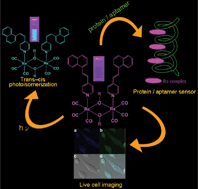We describe the solvothermal synthesis, structural characterization, photophysics and potential applications as probes of two alkoxy-bridged binuclear Re(I) complexes, [{Re(CO)3(1,4-NVP)}2(μ2-OR)2] (1, R = C4H9; 2, R = C10H21; 1,4-NVP = 4-(1-naphthylvinyl)pyridine). Irradiation of 1 and 2 at 365 nm leads to an interesting trans-cis photoisomerization process, which was examined by 1H NMR, UV-vis, emission and time-resolved techniques. Compounds 1 and 2 exhibit photoswitchable luminescence enhancement arising from photoinduced intramolecular energy transfer from the 3MLCT state of the Re(I) chromophore to the triplet excited state of the ligand 1,4-NVP. In addition, these Re(I) complexes serve as excellent probes for the ultrasensitive detection of biological molecules, including bovine serum albumin (BSA) and a platelet derived growth factor (PDGF) binding aptamer. Our results also suggest that, since these Re(I) complexes have low cytotoxicity and fluorescence properties under physiological conditions, they could be a useful probe for optical imaging of cancer cells by confocal laser scanning microscopy.

You have access to this article
 Please wait while we load your content...
Something went wrong. Try again?
Please wait while we load your content...
Something went wrong. Try again?


 Please wait while we load your content...
Please wait while we load your content...